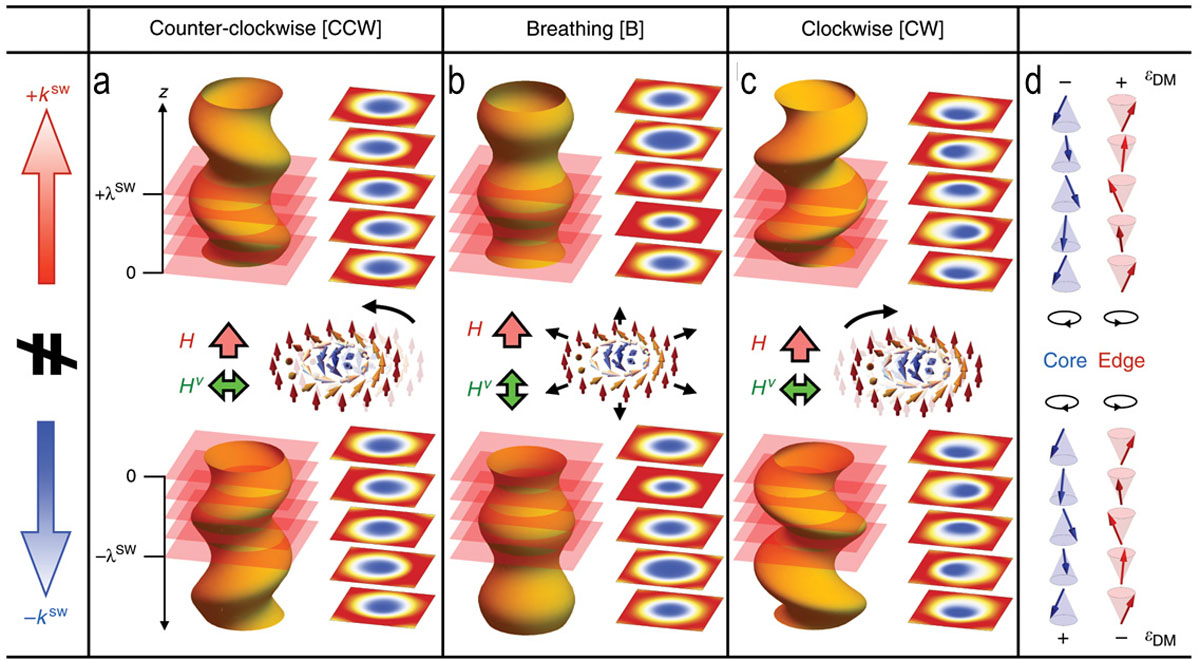Spin Excitations Propagation Dynamics along Skyrmion Strings
Otani Group
Magnetic skyrmions, topological solitons characterized by a two-dimensional swirling spin texture, have recently attracted attention as stable particle-like objects. In three-dimensional systems, the skyrmion can form a string structure by extending in the third dimension, which consists of the uniform stacking of two-dimensional skyrmions along the string direction. Skyrmion strings can be considered as an analog of the vortex line in a superfluid, type-II superconductors, and trapped dilute-gas Bose-Einstein condensates or the cosmic string in the universe. They are all flexible, and some of these strings are proposed to host a resonant oscillation mode propagating through the string path. This implies the possible coherent signal transfer along skyrmion strings, whereas the propagation character of their excitations has rarely been investigated before.
Experimentally, such skyrmion strings appear in a series of bulk magnets with chiral cubic atomic lattice. The examples are metallic B20 or β-Mn-type Co-Zn-Mn alloys and insulating Cu2OSeO3, the latter of which is the target of this work. In these materials, the Dzyaloshinskii–Moriya (DM) interaction is the key to the skyrmion formation. For a limited temperature range, these compounds host a hexagonal lattice of skyrmion strings aligned along the static magnetic field (H) direction. This skyrmion crystal (SkX) phase is predicted to host three distinctive magnetic resonance modes (Fig. 1a–c), i.e., the counter-clockwise (CCW) and clockwise (CW) rotational modes both excited by an oscillating magnetic field Hν⊥H, as well as the breathing (B) mode excited by Hν⁄⁄H, which have recently been identified by magnetic resonance experiments. However, these previous works mostly focused on the character of non-propagating uniform excitations with wave number kSW = 0. To understand their propagation character, the employment of a different experimental approach sensitive to the kSW ≠ 0 regime, as well as the theoretical identification of their dispersion relation, is essential.

Fig. 1. a-c Schematic illustration of CCW, breathing, and CW excitation modes on skyrmion strings. The central part represents the local oscillation manner of skyrmion at the z = 0 plane. The upper and lower parts are the snapshot images describing how the spin excitation launched at z = 0 propagates on the skyrmion strings, along the ±z direction parallel and antiparallel to H, respectively. The cross-sectional images describing the size and position of skyrmion at selected z-planes (shown by red layers) are also indicated. d The direction of the local magnetic moment at the core and edge position of skyrmion in each z layer. Black rounded arrows denote the sense of local moment precession in the time domain, and ± symbols indicate the sign of local Dzyaloshinskii-Moriya interaction energy gain DM.
In the present study, we experimentally demonstrate the coherent propagation of spin excitations along skyrmion strings for the chiral-lattice magnet Cu2OSeO3. We find that the counter-propagating spin excitations show different propagation behavior, and the degree of non-reciprocity, as well as the associated group velocity and decay length, are strongly dependent on the character of the excitation modes. Our theoretically calculated dispersion relations well reproduce these experimental features. The observed decay lengths exceed 50 μm, reflecting the excellent long-range order of the skyrmion-string structure. The present results revealed the peculiar propagation dynamics of skyrmion-string excitations and suggest that skyrmion string can be an excellent medium for magnon transport with unique functionalities. Our combined experimental and theoretical analyses offer a comprehensive account of the propagation dynamics of skyrmion-string excitations and suggest the possibility of unidirectional information transfer along such topologically protected strings.
References
- [1] S. Seki, M. Garst, J. Waizner, R. Takagi, N. D. Khanh, Y. Okamura, K. Kondou, F. Kagawa, Y. Otani, and Y. Tokura, Nat. Commun. 11, 256 (2020).
